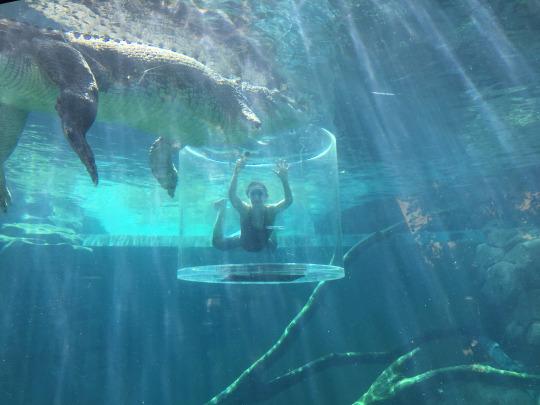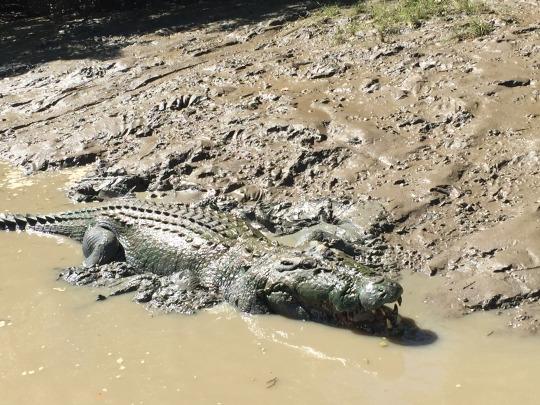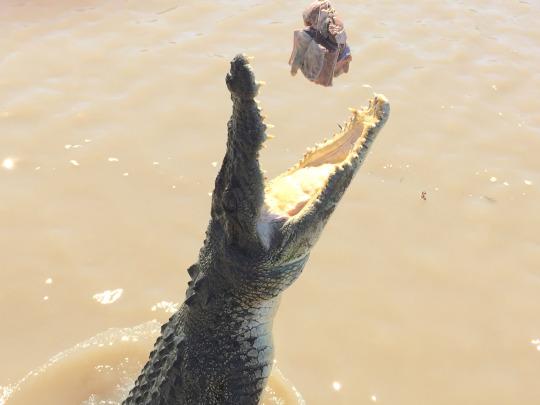Every Thursday and Sunday evening the world meets at the beaches of Darwin, Australia, in the famed Mindil Market. Continue reading
Tag Archives: australia
How to Swim With Crocodiles
Because, boys and girls, this could actually come in handy. I swear. for full croc awesomeness:
Inside the Cage of Death: Swimming With Australia’s Monster Crocs
Ever since I was a child, I’ve had both an obsessive fascination and fear of saltwater crocodiles. They are one of the only creatures alive today that have been around since the prehistoric time of the dinosaurs — in fact, they are considered by some to be living dinosaurs. Since coming back from the brink of extinction in the mid-20th century, anyone venturing into the Australia’s northern territory can see one … just look on the river banks — or the beaches (crocodiles have been known to surf the waves around Darwin, not kidding). But considering they are expert stealth predator, and several people die every year from croc attacks, how close can you get? Pretty close, it turns out.

Yes, you can get this close. And yes, it is terrifying.
But before I hit something called the Cage of Death, I’m going to ease into it. Outside of Darwin, on the banks of the Adelaide River, are the Jumping Croc Cruises, where for $30 dollars you can hop on a flat-bottomed boat with roughly 20 other tourists (no dogs allowed, for obvious reasons) and cruise down the muddy river looking for crocodiles, preferably at feeding times (late morning or evening).
Related: Everything in Australia Wants to Kill You

This guy was about 20 feet long … and very hungry.
Boat staff on the boat lure crocs from the riverbanks by attaching red meat to fishing lines and tapping the water with it.
“They feel the vibration in the water and come,” said our baiter, Kyla. “We like to make them jump so they work for their food and burn some calories. The exertion it takes for them to jump cancels out the calories from the meat, so they do still have to hunt in the wild.”
Related: G’Day Mate! How to Speak Australian

Crocs on the cruise jump as high as five feet for meat — and have been known to jump even higher.
How To Feed Your Crocodile
Because you just never know when this info will come in handy… for full croc awesomeness:
G’Day Mate! How to Speak Australian
Australia is an English-speaking country — but, like with England, there are a lot of differences between here and there. So many, in fact, that if you hang with the locals at a pub in the outback, you won’t be totally off base if you sit for a second and wonder, “Just where the hell am I, anyway?”
Related: Lost in Translation: Whose Language Is It Anyway?
Because quite often, Australian English actually needs a translation.
For example, where you might say, “Sharon’s been working very hard, so when we gave her her birthday present she started crying. She needs to toughen up a bit.” — an Australian would translate that to: “Shazza’s been flat out like a lizard drinking. When we gave her a bidet prezzie, the sheila started crying. She needs to drink a cuppa cement.”
Confused? Don’t worry. I’m here to help so that when you take your big trip down under, you’ll fit right in! Watch the video and then, just for fun, translate your thoughts into Australian in the comments below.
Eating An Alien Lung At Santiago’s Mercado Centrale
I love a food market, especially a fish market. Fun fact: After 8 surgeries on my ears as a child, my auditory orifices are shot so I can’t go diving. Even if I could, being from Ohio and Kentucky, every time I go snorkeling far from the shore I hear the “Jaws” theme pumping in my head. So, yeah. No scuba masks for me. Instead, I go diving by visiting fish markets. Which suits me just fine – that way I can actually touch the fish and check them out without having them swim away or, you know, bite me. Added bonus: Dry Diving means I also don’t have to worry about a bikini wedgie or that weird rash you get from a wet suit.

Yummy. I swear.
I haven’t been to my dream fish market in Tokyo yet, but the one in Sydney Fish Market was pretty insane – with almost everything in the ocean available to poke, prod and squeeze.
So I was pretty stoked to find the fish market in the Mercado Central in Santiago, Chile. My guide, Fanor (velascofanor@hotmail.com), even introduced me to a new sea specimen I hadn’t even heard of: Piure.
